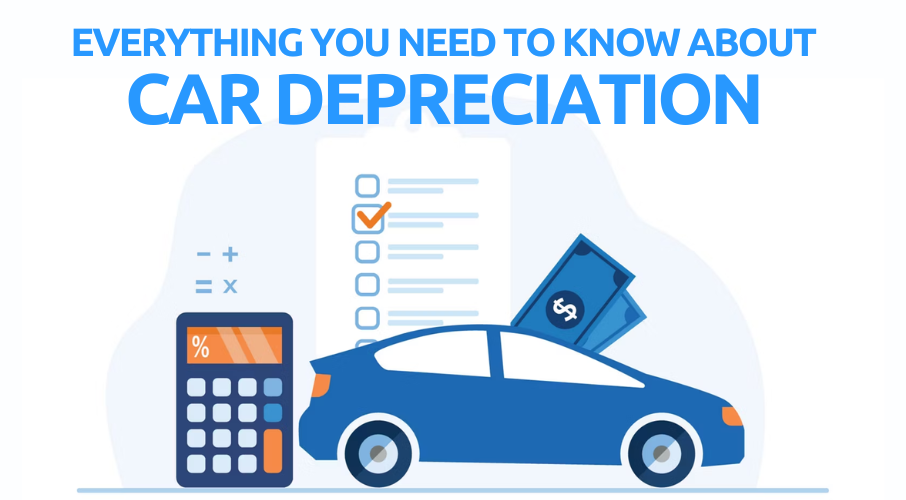Everything You Need to Know About Car Depreciation
Owning or planning to buy a car comes with a key consideration—depreciation. Car depreciation refers to the gradual reduction in a vehicle’s value due to factors such as daily wear and tear, aging, and market trends. Understanding car depreciation is crucial because it directly affects the resale value of your vehicle and the compensation you receive from your insurance provider in the event of a claim.
A deeper understanding of car depreciation, including how it is calculated, can help you make informed decisions about buying, selling, and insuring a car. One useful tool for this purpose is a car depreciation calculator.
Let’s dive into the concept of depreciation, how it affects your car’s value, and how you can use a car depreciation calculator to estimate it.
Understanding Car Depreciation and How to Calculate It
A car depreciation calculator is an online tool designed to provide a quick estimate of your vehicle’s current depreciation rate. This can give you a clear understanding of your car’s present value and its Insured Declared Value (IDV).
The IDV represents the maximum sum your insurance company will compensate you for in case of total loss or theft of the car. To calculate this, subtract the car’s current depreciation rate from its original manufacturer’s price.
There are two primary ways to calculate car depreciation manually:
1. Prime Cost Method
The Prime Cost Method calculates depreciation as a straight-line reduction over the car’s effective life. The formula is:
Cost of running the car × (Number of days you’ve owned the car) ÷ 365 × (100% ÷ Effective life in years)
2. Diminishing Value Method
This method calculates depreciation based on the decreasing value of the car over time. The formula is:
Car’s purchase value × (Number of days you’ve owned the car) ÷ 365 × (200% ÷ Effective life in years)
Although these methods can be used manually, a car depreciation calculator automates the process and provides accurate, real-time estimates.
How to Use a Car Depreciation Calculator
Using a car insurance calculator is a simple and effective way to determine your vehicle’s current depreciation and IDV. Here are the steps to follow:
- Visit a trusted website that provides a car depreciation calculator.
- Enter the ex-showroom price of your car.
- Select the registration year of your vehicle.
- Click the ‘Calculate IDV’ button.
The calculator will instantly provide an estimate of your car’s IDV based on the information provided.
How Does Car Depreciation Affect Buyers and Sellers?
Depreciation plays a critical role in the buying and selling of cars. It directly influences both buyers and sellers, impacting affordability, insurance costs, and resale values.
For Buyers:
Depreciation allows buyers to purchase used cars at significantly lower prices. However, the car’s depreciation rate also affects future resale value and the amount you can claim on insurance.
For Sellers:
Sellers must carefully consider depreciation when setting their car’s price. A higher depreciation rate can reduce profit margins and make the car less competitive in the market. On the flip side, knowing the car’s depreciation rate can help sellers set more realistic, attractive prices and position the car effectively in the used car market.
Being aware of depreciation rates can lead to better financial outcomes, ensuring that both buyers and sellers make informed and fair transactions.
Why is Depreciation an Important Factor to Consider?
Car depreciation is particularly important when it comes to car insurance because it directly affects the amount of compensation you receive during claim settlements. Over time, a car’s value decreases due to wear and tear, which insurance companies take into account when processing claims.
When you file a claim for damages, insurers usually calculate the payout based on the depreciated value of the damaged parts. Understanding this process ensures you receive adequate compensation, covering repair or replacement costs effectively.
Ways to Minimise Car Depreciation
While car depreciation is unavoidable, there are several ways to reduce its impact:
1. Regular Maintenance
Consistent servicing and repairs help maintain your car’s value and slow down the depreciation rate.
2. Avoid Overloading
Overloading your vehicle accelerates wear and tear, which in turn speeds up depreciation.
3. Practice Responsible Driving Habits
Safe driving reduces mechanical strain, minimizing the impact on the car’s engine and parts, which helps preserve its value.
4. Park in a Garage
Protecting your car from environmental factors like rain, sun, and hail can prevent long-term damage.
5. Use Protective Measures
Applying rust-proofing and paint protection coatings extends the lifespan of the car’s exterior, which contributes to maintaining its resale value.
Rate of Car Depreciation in Insurance
To standardize the depreciation process across insurance companies, the Insurance Regulatory and Development Authority of India (IRDAI) sets depreciation rates based on the car’s age.
The table below shows the depreciation rates as per the age of the car:
| Car Age | Depreciation Rate |
|---|---|
| 0 – 6 months | 5% |
| 6 months – 1 year | 15% |
| 1 – 2 years | 20% |
| 2 – 3 years | 30% |
| 3 – 4 years | 40% |
| 4 – 5 years | 50% |
| Above 5 years | Negotiated with insurer |
Additionally, different car components are subject to varying depreciation rates:
| Component | Depreciation Rate |
|---|---|
| Rubber, nylon, plastic parts | 50% |
| Glass components | Nil |
| Fiberglass components | 30% |
| Paintwork | 50% |
These rates may be revised by IRDAI from time to time.
How Does Car Depreciation Affect Your Car Insurance Plan?
When you file a claim under your car insurance policy, the payout you receive is generally adjusted based on the applicable depreciation rate, which is determined by the car’s age.
For instance, imagine Mr. Navin files a claim for his 2.5-year-old car, with total repair costs amounting to ₹15,000. Given that the depreciation rate for his car is 30%, the deductible depreciation amount will be ₹4,500, leaving him with a claim payout of ₹10,500 (excluding other deductibles).
If you wish to avoid deductions based on depreciation, consider opting for a Zero Depreciation Add-On with your comprehensive car insurance plan. While this add-on may increase your premium, it ensures you receive the full claim amount in the event of damage, without depreciation cuts.
What Factors Affect the Depreciation Value of a Car?
Several factors influence a car’s depreciation value, which in turn affects its IDV. Here are some key considerations:
1. Age of the Car
Older cars depreciate faster than newer ones.
2. Fuel Efficiency
Cars with higher fuel efficiency tend to hold their value better in the resale market.
3. Maintenance
A well-maintained car will have a lower depreciation rate, increasing its resale value.
4. Make and Model
Compact, fuel-efficient cars typically depreciate at a slower rate than luxury or niche vehicles.
Conclusion
Car depreciation is a critical factor that affects both buyers and sellers in the automotive market. By understanding how depreciation works, individuals can make informed decisions regarding the purchase, sale, and insurance of their cars.
By taking steps to reduce depreciation, such as regular maintenance, responsible driving, and protective measures, car owners can retain the value of their vehicle for a longer time. Ultimately, a solid grasp of depreciation empowers buyers and sellers to optimize financial outcomes and ensure fair transactions in the car market.
Frequently Asked Questions (FAQs)
Cars that depreciate the fastest in India often include models with high initial depreciation, low demand in the used car market, and high maintenance costs. These may include certain luxury vehicles or cars with limited popularity.
The slowest depreciating cars tend to be those with high demand in the used car market, solid brand reputation, and good reliability. These factors contribute to their ability to hold value over time.
The Written Down Value (WDV) of a car is calculated by subtracting the accumulated depreciation from the original cost. The formula is: WDV = Original Cost – (Depreciation Rate × Original Cost × Number of Years Used)
You can calculate car depreciation using either the Prime Cost or Diminishing Value methods. Both require the car’s purchase price, depreciation rate, and time of ownership.
Two common methods are:
Diminishing Value Formula: Purchase value × (Number of days owned ÷ 365) × (200% ÷ Effective life in years)
Prime Cost Formula: Cost of running the car × (Number of days owned ÷ 365) × (100% ÷ Effective life in years)
Also Read: How to Cancel Your Car Insurance Policy and Get a Refund: A Step-by-Step Guide











Post Comment